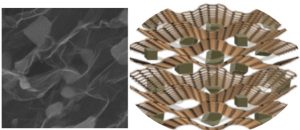[Paper: Self-Assembled and One-Step Synthesis of Interconnected 3D Network of Fe3O4/Reduced Graphene Oxide Nanosheets Hybrid for High-Performance Supercapacitor Electrode. Rajesh Kumar, Rajesh K. Singh, Alfredo R. Vaz, Raluca Savu, Stanislav A Moshkalev. ACS APPLIED MATERIALS & INTERFACES. 2017, 9, 8880 – 8890. DOI: 10.1021/acsami.6b14704].
Nanosheets and nanoparticles interconnected for wearable electronics
A team of researchers from the State University of Campinas (Unicamp), in Brazil, and a researcher from the Central University of Himachal Pradesh (CUHP), in India, have developed a flexible and tiny high-performance supercapacitor with a hybrid material made of graphene oxide (GO) nanosheets and iron oxide (Fe3O4) nanoparticles. The work was recently reported in the journal Applied Materials & Interfaces (impact factor 7.145), of the American Chemical Society.
“The main contribution of this work is for the new and really promising research area of flexible electronics”, says PhD Rajesh Kumar, researcher at Unicamp’s Center for Semiconductor Components (CSC) and corresponding author of the article. “Since capacitors are among the main components of electronic devices, these performant and flexible graphene oxide-based microsupercapacitors can be used in the near future as components in wearable and flexible electronic devices (mobile phones, smart watches, health monitoring devices, energy storage devices etc.)”, adds the Indian born researcher.
The genesis of the study goes back to 2015, when Rajesh Kumar, who had been working with graphene microsupercapacitors in other countries, applied for a postdoctoral fellowship to work in the group of Professor Stanislav Moshkalev, director of CSC at Unicamp. “I saw a great opportunity in this group, as their main research line is nanofabrication and nanoelectronics based on nanostructured carbon,” reports Kumar. The Indian PhD obtained a grant from CNPq, the Brazilian federal research agency, as a visiting specialist, to carry out a project in CSC – Unicamp. Initially, he made fine sheets of graphene oxide called “buckypapers”. Then, working in interaction with a group of five other people of CSC – Unicamp, he searched for new strategies to improve the properties of the material.
The CSC- Unicamp team thus faced the challenge of making a hybrid material of graphene and iron oxide with controlled structure using a simple process, and it was successful in do so by simply exposing graphite oxide and ferric chloride (FeCl3) to microwave radiation.

The obtained material presented an interesting morphology: a three-dimensional network in which interconnected graphene nanosheets form “tunnels” that harbor crystalline and multifaceted iron oxide nanoparticles of 50 – 200 nm, strongly attached to the nanosheets, as shown in the figure beside.
The morphology, structure, composition, thermal stability and other properties were analyzed using several techniques available at CSC – Unicamp and at the Indian university.
Subsequently, at Unicamp, the team tested the efficiency of the material to act as electricity storage. The tests proved the high performance of the material as a supercapacitor electrode, and the scientific team concluded that this efficiency was favored by the special morphology of the 3D hybrid material. Particularly, by the faceted nanoparticles strongly attached to the nanosheets, the separation among the nanosheets, the “tunnels” that shelter individual nanoparticles avoiding agglomerations, and the large surface area of the network of nanosheets.
“These microsupercapacitors can and for sure will, in the near future, replace the traditional capacitors in electronic devices,” says Kumar. According to the researcher, their main advantages are high performance, mechanical strength, reduced size and, most important, flexibility – an essential property for wearable electronics.
In addition, the method developed by the Unicamp and CUHP team can become a good alternative to fabricate other hybrid materials based on carbon and metal oxides.
The work was carried out with financial support from CNPq and FAPESP (the São Paulo State research foundation).

